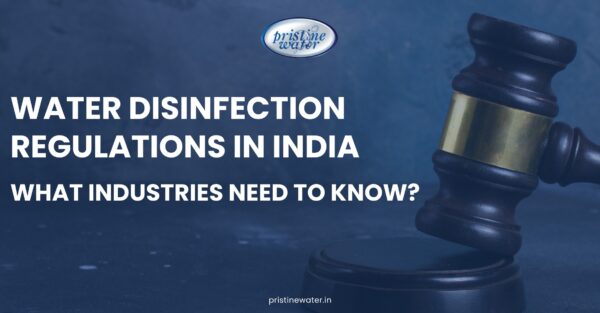
Regulatory Shifts in Water Disinfection: What Indian Industries Need to Know
Regulatory Shifts in Water Disinfection: What Indian Industries Need to Know
India is witnessing a pivotal shift in how water pollution and disinfection are regulated. With an increased emphasis on sustainability, environmental protection, and public health, the government is tightening standards and streamlining enforcement. For industries, especially those with high water usage or effluent discharge, these regulatory changes are not just mandates — they are opportunities for transformation.
At Pristine Water, we understand the challenges industries face when adapting to regulatory updates. With over two decades of expertise in water disinfection technologies, we’re here to help you navigate the compliance landscape effectively.
Key Regulatory Updates You Can’t Ignore
The Water (Prevention and Control of Pollution) Amendment Bill, 2024
This amendment to the historic 1974 Act modernizes India’s approach to water pollution. Key changes include:
- Decriminalization of minor violations, replacing imprisonment with financial penalties. Initial implementation in states like Himachal Pradesh and Rajasthan, with others likely to follow.
- A shift towards consistent, pan-India standards.
Read More: PSRIndia- The Water Amendment Bill-2024
Control of Water Pollution Guidelines, 2025
Rolled out by the Ministry of Environment, Forest and Climate Change (MoEFCC), these guidelines are effective from January 30, 2025, and bring major changes:
- High-pollution industries must be at least 500 meters away from water bodies and residential areas, while medium- and low-pollution industries face shorter but still significant distance requirements.
- Industries must apply for permission, pay fees, and undergo inspections before starting operations. The process is now more transparent, with clear timelines and rebates for early renewals.
- National and state-level monitoring committees have been established for better oversight and enforcement.
Read More: India’s 2025 Water Pollution Guidelines
Ongoing Obligations Under Existing Acts
Industries must comply with the Water (Prevention and Control of Pollution) Act, 1974, and the Environment (Protection) Act, 1986. These laws require industries to obtain consent to operate, set up effluent treatment plants (ETPs), and adhere to strict discharge standards. Non-compliance can result in hefty penalties, factory shutdowns, and legal prosecution
- Valid Consent to Operate (CTO) and Consent to Establish (CTE).
- Functional Effluent Treatment Plants (ETPs).
- Strict adherence to discharge standards.
What This Means for Water Disinfection and Treatment
Tighter Effluent Standards
The Central Pollution Control Board (CPCB) and State Pollution Control Boards (SPCBs) set and enforce effluent discharge standards. Industries must ensure that treated wastewater meets these standards before discharge into water bodies, public sewers, or land for irrigation. The new guidelines further tighten these requirements, especially for high-pollution sectors.
Mandatory Water Audits
Water audits are increasingly required, especially for large-scale or polluting units. These audits:
- Benchmark current practices.
- Highlight areas for conservation and optimization.
- Help avoid non-compliance penalties.
Demand for Advanced Technologies
There is a clear push towards innovative disinfection solutions that are:
- Sustainable
- Energy-efficient
- Low-maintenance
- Safer than conventional chlorination
What Industries Must Do
- Stay Updated: Regularly monitor regulatory updates from the MoEFCC, CPCB, and SPCBs.
- Invest in Compliance: Allocate resources for advanced water treatment and disinfection technologies.
- Conduct Water Audits: Implement regular water audits to ensure compliance and identify areas for improvement.
- Train Staff: Educate employees on regulatory requirements and best practices for water management.
Conclusion
The regulatory landscape for water disinfection and pollution control in India is undergoing significant transformation. Industries must adapt to stricter standards, leverage technology, and prioritize compliance to thrive in this new environment. By doing so, they not only avoid penalties but also contribute to a cleaner, healthier, and more sustainable future for all
